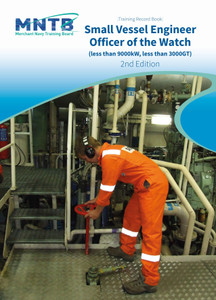
This book discusses small vessel stability, with reference to the MCA’s Small Vessel Safety Codes, and is written for all who operate, design, construct or survey small commercial or recreational vessels or are studying to do so. It provides essential information on the requirements and content of the ship Stability Information Book, which will benefit Masters when preparing for and undertaking their mandatory stability course prior to assuming command. It will also enable Code examiners and surveyors to understand the reasoning behind the requirements of Section 11 and to exercise intelligent judgement on the continuing safe relationship between a ship’s Stability Book and the ship’s condition during inspections.
This book has been revised and updated following publication of the MCA’s 2018 Second Edition of the Workboat Code.
It provides an introduction to ship stability, weight, centre of gravity and hydrostatic information, and then guides the reader through the calculations necessary to maintain buoyancy and stability. It discusses how to conduct inclining experiments and roll tests and how to use the results.
Detailed information is provided on loading condition and free surface effects, together with calculation of the associated flotation and stability characteristics.
Further chapters cover stability acceptance criteria, trim, the downflooding angle, damage survivability, the use of lifting devices and the stability of sailing vessels.
The metric system of measurement is used throughout and the author’s original hand-drawn sketches have been retained to illustrate the text.
The author hopes that the reader, who develops an understanding of the subject matter, will then be able to follow the Safety Codes and the ISO Standards, and will begin to understand some of the important basics of naval architecture that keep ships and small vessels The Right Way Up.
These notes on the Stability of Small Vessels do not give a definitive study of the subject but have been written to explain, for the layman, the parts of the subject that are covered in the MCA’s Small Vessel Safety Codes.
It is intended that this book will assist skippers to understand and apply the requirements and information contained in their vessels’ Stability Information Book and when preparing for and undertaking their mandatory stability course, prior to assuming command.
The book is also intended to enable Code examiners and surveyors to understand the reasoning behind the requirements of Section 11 and to exercise intelligent judgement on the continuing safe relationship between a vessel’s Stability Book and its current condition during inspections.
With the recent development and approval by the Government of an apprenticeship for marine surveyors, this book will provide a useful introduction to stability for young persons coming into this profession without prior experience at sea.
The stability design standard supporting the EU Recreational Craft Directive (RCD),
ISO 12217 – Parts 1 and 2, is mentioned in places as alternatives to some sections of the Codes. These are extremely useful additional instructions on small vessel stability. However, care must be taken when considering the stability of RCD vessels – see the Cautionary Note that follows this Introduction.
The metric system of measurement is used throughout and the author’s original hand-drawn sketches have been retained to illustrate the text.
The author hopes that the reader, who develops an understanding of the subject matter, will then be able to follow the Safety Codes and the ISO Standards. Thus, the reader will begin to understand some of the important basics of naval architecture that keep ships and small vessels The Right Way Up.
Ted Penny
MCA Note
At the beginning of the 21st century, there were several ‘Codes of Practice’ covering the Safety of Small Vessels (up to 24 metres in length), published and enforced by the MCA, including:
The Safety of Small Vessels in Commercial Use for Sport or Pleasure Operating from a Nominated Departure Point (NDP) (the Red Code)
The Safety of Small Commercial Sailing Vessels (the Blue Code) The Safety of Small Commercial Motor Vessels (the Yellow Code) The Safety of Small Workboats and Pilot Boats (the Brown Code).
Due
to
the
then
Government’s
drive
to
simplify
regulation,
it
was
considered
necessary
to
‘harmonise’
these
Codes.
This
was
done
by
condensing
them
all
into
one
volume
and
referring
to
it
as
the
‘Harmonised
Code’,
published
as
an
Annex
to
Marine
Guidance
Notice
MGN
280
(M),
Small
Vessels
in
Commercial
Use
for
Sport
or
Pleasure,
Workboats
and
Pilot
Boats
–
Alternative
Construction
Standards,
which
is
applicable
under
the
original
UK
Statutory
Instruments
as
a
revision
of
the
technical
standards
required.
The MCA published a new ‘Second Edition’ of the Workboat Code in December 2018. Its Section 11 is applicable to and draws from the original Red, Blue and Yellow Codes, pending their revision, which is currently in hand.
The above information was correct at the time of this document’s publication.
Contents
Other
Books
in
this
Series
iii
Foreword
v
Second
Edition
vi
Introduction
vii
Recreational
Craft
Directive
–
Cautionary
Note
–
ISO
12217
Stability
Assessment
ix
Chapter
1
Introduction
to
Stability
1
1.1
Background
3
1.2
Definitions
3
1.3
Symbols
4
1.4
Initial
conditions
of
stability
6
Chapter
2
Weight
and
Centre
of
Gravity
9
2.1
Initial
estimate
of
Lightship
Weight
and
Centre
of
Gravity
11
2.2
Estimate
of
vessel
weight
(Displacement)
and
CG
in
operation
11
Chapter
3
Hydrostatic
Information
13
3.1
Hydrostatics
15
3.2
Righting
Levers
15
Chapter
4
Keeping
the
Vessel
Upright
17
4.1
Metacentre
(from
the
Greek
μετα:
‘After’
–
i.e.
calculated
fro,
known
factors)
19
4.2
Stability
at
small
angles
and
GM
23
4.3
Stability
at
larger
angles
and
the
GZ
curve
24
Chapter
5
The
Inclining
Experiment
27
5.1
Why
is
it
done?
29
5.2
How
is
it
done?
29
5.3
How
do
you
use
the
results?
32
Chapter
6
Alternative
Stability
Checking
by
Roll
Moment
39
6.1
Background
41
6.2
Principle
and
procedure
41
6.3
Roll
moment
method
–
summary
42
Chapter
7
Loading
Conditions
45
7.1
Loading
Condition
47
7.2
Free
Surface
Effects
48
7.3
Typical
GZ
curve
52
7.4
Maximum
permissible
KG
curve
53
Chapter
8
Stability
Acceptance
Criteria
55
8.1
Normal
acceptance
criteria
for
a
vessel
57
8.2
Acceptance
criteria
for
a
catamaran
or
multihull
vessel
that
cannot
meet
the
requirements
of
8.1
58
8.3
Acceptance
criteria
for
motor
vessels
complying
with
Annex
Section
11.1.1.3
58
Chapter
9
Trim
61
Chapter
10
Downflooding
Angle
67
10.1
What
is
the
Downflooding
Angle?
69
10.2
Critical
Angle
of
Downflooding
69
Chapter
11
Damage
Survivability
71
11.1
Floodable
length
curves
73
11.2
Damage
stability
76
11.3
Criteria
for
damage
stability
assessment
77
Chapter
12
Cranes
and
Suspended
Weights
79
12.1
Fitting
a
crane
81
12.2
Stability
considerations
81
12.3
GZ
and
heeling
curves
81
12.4
Criteria
for
acceptance
of
vessel
with
lifting
device
or
crane
83
12.5
Crane
testing
83
Chapter
13
Stability
of
Sailing
Vessels
85
13.1
Background
87
13.2
Wind
curves
88
13.3
Gusts
and
Squalls
–
definitions
89
13.3.1
Preventing
downflooding
in
Gusts
89
13.3.2
Preventing
downflooding
in
Gusts
and
Squalls
91
13.4
Sailing
multihulls
93
13.5
STOPS
Numeral
94
13.6
Stability
and
safety
screening:
the
SSS
Numeral
96
13.7
The
stability
index:
STIX
96
References
99
Appendices
103
Appendix
1
105
Appendix
2
108
Appendix
3
109
Appendix
4
110
- Number of Pages:
- 113
- Book Height:
- 246 mm
- Book Width:
- 189 mm
- Weight:
- 0.8 kg
- Author:
Hylton Edward Penny, CEng, CmarEng, FIMarEST, MRINA
- Published Date:
- November 2021
- Binding Format:
- Softback
- Preview:
- Yes
- ISBN:
- 9781914992131
- Publication Date:
- November 2021






